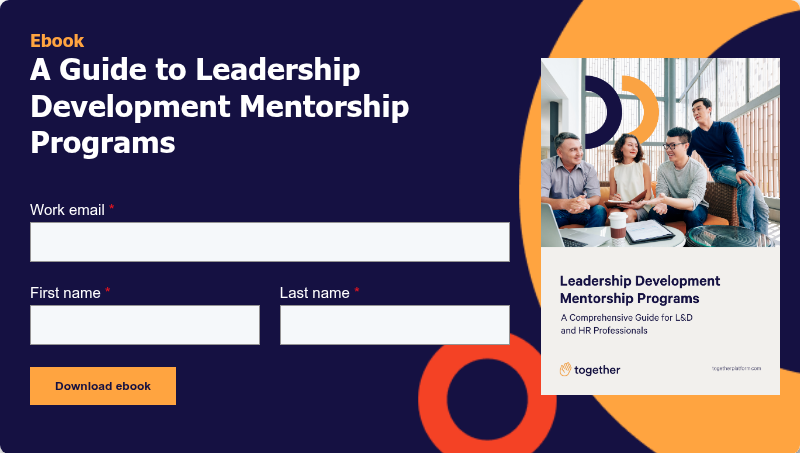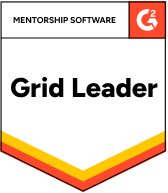Picture this: Sarah, a high-potential engineer at a Fortune 500 company, just got promoted to team lead. She's technically brilliant, but now she's drowning in people management challenges she never saw coming. Sound familiar?
According to LinkedIn's Workplace Learning Report, while 50% of upskilling and reskilling programs make it through the activation stage, only 4% reach the measurement stage—meaning most leadership development programs fail before employees can actually benefit from them.
The answer isn't another generic leadership course or one-size-fits-all training module. The solution lies in something far more personal and proven: a well-designed mentorship program.
What makes leadership mentorship programs different
A leadership development mentorship program is a structured initiative that pairs emerging leaders with experienced mentors to accelerate leadership skill development through relationship-based learning. But here's where many organizations miss the mark—this isn't just about having seasoned executives grab coffee with junior employees once a quarter.
Effective leadership mentorship programs are strategic, structured, and surprisingly sophisticated. They combine the personal connection of traditional mentorship with the measurable outcomes that modern organizations demand.
The core components that separate successful programs from well-intentioned failures include:
- Intentional matching based on complementary skills, career goals, and development areas
- Structured frameworks that provide clear guidelines while allowing organic relationship development
- Skills-focused development targeting specific leadership competencies like emotional intelligence and strategic thinking
- Measurable outcomes through goals, feedback loops, and performance metrics
Understanding your program structure options
When designing your leadership mentorship program, you'll need to choose between several structural approaches. Each has distinct advantages depending on your organizational goals and participant preferences.
One-to-one mentorship
The traditional model pairs one mentor with one mentee for intensive, personalized development. This format works exceptionally well for high-potential employees preparing for significant leadership transitions.
Best for:
- Executive succession planning
- Developing emerging leaders for specific roles
- Cross-functional leadership development
- Organizations with experienced mentor pools
Key considerations:
- Requires significant mentor time investment
- Can be resource-intensive to scale
- Creates deep, lasting developmental relationships
- Allows for highly customized development plans
Group mentorship
One experienced leader mentors a small group of emerging leaders (typically 4-6 participants). This approach leverages peer learning while providing expert guidance.
Best for:
- Organizations with limited mentor availability
- Developing cohorts of similar-level leaders
- Building networks among emerging leaders
- Sharing common leadership challenges across teams
Key considerations:
- Participants learn from each other's experiences
- Requires skilled facilitators to manage group dynamics
- May provide less individualized attention
Peer mentorship
Colleagues at similar levels partner to support each other's leadership development. This model recognizes that learning happens horizontally, not just vertically.
Best for:
- First-time managers facing similar challenges
- Cross-departmental collaboration building
- Organizations with flat hierarchies
- Supplementing formal leadership training
Key considerations:
- Builds strong internal networks
- Highly scalable
- Requires clear structure to maintain focus
- May need occasional expert guidance
Reverse mentorship
Younger or more junior employees mentor senior leaders, often around technology, innovation, or cultural trends. This model breaks traditional hierarchies while developing leadership skills in unexpected ways.
Best for:
- Digital transformation initiatives
- Diversity and inclusion efforts
- Innovation and change management
- Bridging generational gaps
Key considerations:
- Challenges traditional power dynamics
- Develops leadership confidence in junior employees
- Requires cultural openness from senior leaders
- Can accelerate organizational learning
Aligning your program with organizational goals
Your mentorship program should directly support your organization's strategic objectives. Without this alignment, even the best-designed program becomes an expensive nice-to-have rather than a business necessity.
Start with strategic assessment
Before designing any program elements, conduct a thorough assessment of your organization's leadership development needs:
Current state analysis:
- What leadership gaps exist today?
- Where are you losing high-potential talent?
- What leadership competencies drive business success?
- How do current development programs perform?
Future state vision:
- What leadership capabilities will you need in 3-5 years?
- How will industry changes affect leadership requirements?
- What succession planning challenges must you address?
- How does leadership development impact your competitive advantage?
The SMART-ER framework for mentorship goals
Transform your strategic assessment into specific program objectives using the SMART-ER framework:
- Specific: Target particular leadership competencies
- Measurable: Include quantifiable outcomes
- Achievable: Set realistic expectations
- Relevant: Align with business objectives
- Time-bound: Establish clear timelines
- Evaluated: Build in assessment checkpoints
- Readjusted: Allow for program evolution
Example goal: "Increase internal promotions to senior management roles by 30% within 18 months by developing strategic thinking and team management skills in high-potential employees through structured mentorship relationships."
Integration with existing systems
Your mentorship program shouldn't exist in isolation. Integrate it with your broader talent management ecosystem:
Performance management integration:
- Include mentoring goals in individual development plans
- Incorporate mentorship participation into performance reviews
- Align mentorship objectives with promotion criteria
Learning and development alignment:
- Complement formal training with practical application
- Use mentorship to reinforce leadership competency models
- Connect mentorship experiences to career pathing
Succession planning connection:
- Identify mentorship participants through succession planning
- Use mentorship to prepare high-potential employees for advancement
- Track mentorship alumni in leadership pipeline analytics
Designing your program framework
With your structure and alignment defined, you can design the specific framework that will guide participant interactions and program administration.
Program duration and intensity
Research shows that meaningful mentorship relationships require time to develop. At Together, we've found that 12-18 months provides enough time for relationship development and skill building. Shorter programs feel rushed; longer ones risk losing momentum.
Recommended framework:
- Program duration: 12-18 months
- Meeting frequency: Monthly 60-90 minute sessions
- Structured touchpoints: Quarterly program-wide events
- Flexibility buffer: Allow for additional meetings as needed
Essential program elements
Your program framework should include these core components:
Launch phase (Month 1):
- Kickoff session bringing all participants together
- Goal-setting workshops for mentor-mentee pairs
- Expectation setting and program overview
- Initial relationship building activities
Development phase (Months 2-11):
- Regular mentor-mentee meetings
- Mid-program check-ins and group sessions
- Skills-building modules on leadership topics
- Networking events for cross-pair learning
Completion phase (Month 12):
- Capstone projects showcasing applied learning
- Celebration and recognition events
- Transition planning for ongoing development
Creating flexibility within structure
The most successful programs provide clear frameworks while allowing relationships to develop organically. Here's how to balance structure with flexibility:
Structured elements:
- Program timeline and milestones
- Goal-setting templates and tools
- Resource libraries and conversation guides
- Progress tracking and feedback mechanisms
Flexible elements:
- Meeting frequency and format preferences
- Conversation topics and development focus areas
- Communication styles and interaction methods
- Additional activities and learning opportunities
Technology considerations
While relationships remain the heart of mentorship, the right technology platform becomes essential for programs at scale. Consider these technology requirements:
Matching capabilities:
- Data-driven pairing based on multiple criteria
- Preference collection and compatibility analysis
- Trial periods and re-matching options
Relationship management:
- Goal setting and progress tracking tools
- Communication platforms and scheduling
- Resource libraries and conversation guides
- Progress monitoring and milestone tracking
Program administration:
- Real-time analytics and engagement metrics
- Automated workflows and notifications
- Reporting capabilities for stakeholder updates
- Integration with existing HR systems
Discover how Andy Wade, Training Programs Manager at Gordian, uses Together’s administrative tools to run high-impact programs with very little oversight.
Implementation best practices
As you move from design to implementation, keep these best practices in mind:
Pilot before full launch
Start with a smaller group (20-30 pairs) to identify issues before full rollout. This allows you to:
- Test matching processes and compatibility
- Refine program materials and resources
- Identify training gaps and support needs
- Build internal success stories and advocates
Invest in training
Both mentors and mentees need preparation for success:
Mentor training should cover:
- Effective feedback and coaching techniques
- Different mentoring styles and approaches
- Goal setting and development planning
- Managing challenging conversations
Mentee training should include:
- How to be coachable and receive feedback
- Setting realistic expectations and boundaries
- Maximizing learning opportunities
- Taking ownership of development goals
Maintain ongoing support
Successful programs provide regular touchpoints without being intrusive:
- Quarterly pulse surveys to identify issues early
- Optional group sessions for troubleshooting and best practice sharing
- Resource updates and new development tools
- Clear escalation paths when relationships need help
Measuring and evolving your design
Your program design should evolve based on data and feedback. Track both leading indicators (relationship quality, goal completion, engagement) and lagging indicators (promotions, retention, performance improvements).
Key metrics to monitor:
- Participant satisfaction and Net Promoter Scores
- Meeting frequency and engagement quality
- Goal achievement and competency development
- Business outcomes like promotion and retention rates
Use this data to continuously refine your program design, ensuring it remains aligned with organizational needs and participant expectations.
Ready to build your leadership mentorship program?
Designing a leadership mentorship program that actually works requires careful planning, strategic alignment, and ongoing commitment. But when done right, these programs create transformational experiences that develop stronger leaders, improve retention, and drive business results.
The examples and frameworks in this guide provide a starting point, but every organization's needs are unique. For a comprehensive deep-dive into building effective leadership mentorship programs, including detailed implementation guides, measurement frameworks, and real-world case studies, download our complete ebook: "Leadership Development Mentorship Programs: A Comprehensive Guide for L&D and HR Professionals."
This resource includes everything you need to design, launch, and scale a mentorship program that delivers measurable business impact while developing the leaders your organization needs for the future.
Download the Leadership Development Mentorship Programs Ebook →



.svg)







.svg)

